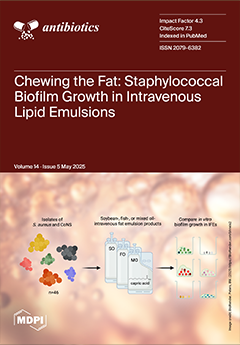Background: Antimicrobial resistance (AMR) represents a critical global health challenge, requiring innovative strategies to combat resistant bacterial strains.
Cymbopogon essential oils (EOs) are promising natural antimicrobial agents.
Methods: The EO of
Cymbopogon commutatus was extracted by hydrodistillation from fresh aerial parts
[...] Read more.
Background: Antimicrobial resistance (AMR) represents a critical global health challenge, requiring innovative strategies to combat resistant bacterial strains.
Cymbopogon essential oils (EOs) are promising natural antimicrobial agents.
Methods: The EO of
Cymbopogon commutatus was extracted by hydrodistillation from fresh aerial parts and compared to commercial EOs from
C. citratus,
C. nardus, and
C. winterianus. Antibacterial activity was evaluated against seven bacterial strains (two Gram-positive and five Gram-negative). Both water-soluble fractions and liposome-encapsulated formulations were tested. Liposomes were prepared using soybean lecithin, and their stability was assessed by dynamic light scattering (DLS). The chemical composition of the pure EOs, water-soluble fractions and non-water-soluble fractions was analyzed by gas chromatography–mass spectrometry (GC-MS).
Results: Liposome encapsulation improved EO solubility in aqueous media and significantly enhanced antibacterial efficacy, reducing minimum inhibitory concentration (MIC) values compared to the water-soluble fractions (MICs ≥ 25%). Among the tested formulations, the liposome containing
C. citratus EO exhibited the strongest inhibitory effect against
Staphylococcus aureus (MIC: 0.04%) followed by liposomes with
C. nardus and
C. commutatus (MIC: 0.08%). Against
Enterococcus faecalis, the most effective formulation was the liposome containing
C. winterianus EO (MIC: 0.02%), followed by
C. citratus (MIC: 0.08%). The liposome formulated with
C. winterianus maintained its particle size over 72 h without phase separation. GC-MS analysis revealed distinct phytochemical profiles:
C. commutatus EO was rich in piperitone (73.9%) and
C. citratus was rich in (Z)-(3,3-Dimethyl)-cyclohexylideneacetaldehyde (39.9%) and citral (32.5%), while
C. nardus and
C. winterianus were dominated by geraniol (21.5%) and citronellal (30.8%), respectively. Notably, piperitone, the major compound in
C. commutatus EO, exhibited strong antibacterial activity against
S. aureus (MIC of <0.04%).
Conclusions: These findings support the potential of liposome-encapsulated
Cymbopogon EOs as an effective and sustainable strategy to address AMR. This study provides a foundation for the development of plant-based antimicrobial formulations with improved efficacy.
Full article






